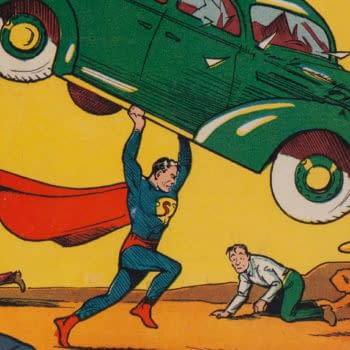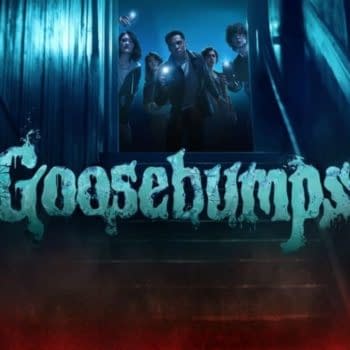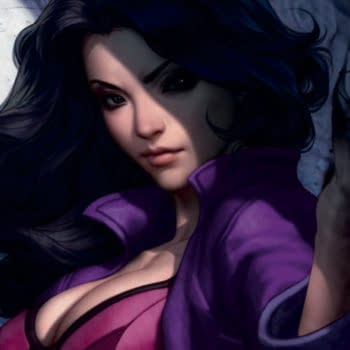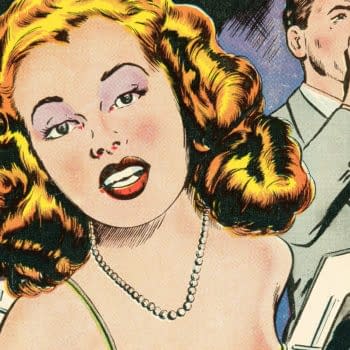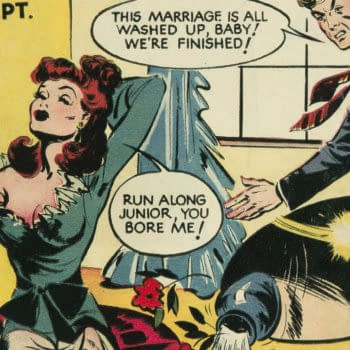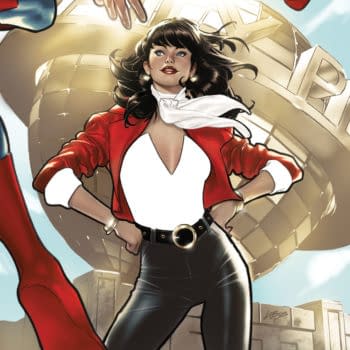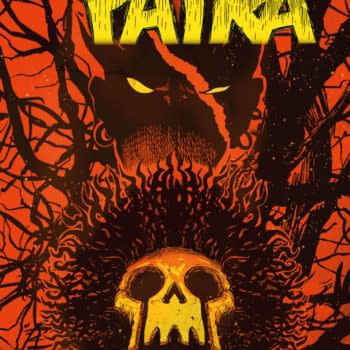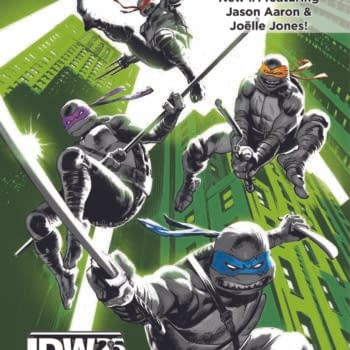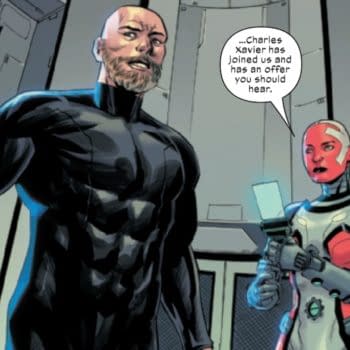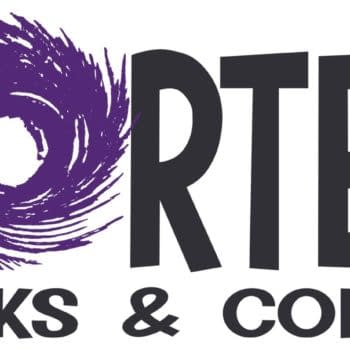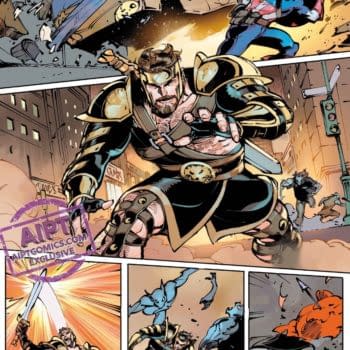Posted in: Comics, Recent Updates | Tagged: Comics, disney, jack kirby, lawsuit, marvel
Latest Round In Marvel/Disney Vs Jack Kirby's Family… Is A Split Decision

On September 16, 2009, Kirby's family served Marvel with notice to terminate Marvel's copyright on numerous Kirby-created properties
Two weeks after Disney announced they would be acquiring Marvel for $4 Billion, Jack Kirby's son and daughters — Lisa, Barbara, Neal, and Susan — served Marvel and others with notices under 17 USC 304 to terminate grants of copyrights to works Kirby created before January 1, 1978. Attorney for the Kirby family Marc Toberoff, well-versed in such matters from his representation of the Siegel and Shuster families in their ongoing (and thus far successful) conflict with DC/Warners over Superman rights, sent 45 notices of copyright termination to Disney, Marvel, and various movie studios.
The period covered would of course include the dawn of what we now call the Marvel Universe — and Kirby had a hand in a large part of it. Hulk, Iron Man, Avengers, X-Men, Thor, and on and on.
On January 8, 2010, Marvel filed suit in federal court in Manhattan seeking a declaration that the Kirby Family's notices of termination are invalid
In a move that the New York Times says stunned Toberoff, Marvel broke off settlement talks to file suit to invalidate the notices. The public statements during this turn of events by both Marvel and the Kirby Family are worthy of further examination.
Marvel's lawyers issued a press release asserting the "works made for hire" nature of the characters created by Kirby, which is of course a familiar phrase in the comics industry.
"The notices filed by the heirs are an attempt to rewrite the history of Kirby's relationship with Marvel," said John Turitzin, Marvel's General Counsel. "Everything about Kirby's relationship with Marvel shows that his contributions were works made for hire and that all the copyright interests in them belong to Marvel."
Under federal copyright law, works that were created at the "instance and expense" of a publisher during the time Kirby was a creator for Marvel were "works made for hire" and owned by that publisher. If, for example, Marvel gave a writer or artist an assignment to create a comic book story populated with new characters or to illustrate a comic book story with depictions of its characters – and paid the writer or artist for carrying out the assignment – the publisher, not the writer or artist, would own the copyright. All of Kirby's contributions to Marvel comic books the heirs are claiming for themselves fall into this category.
The Kirby Family responded via Toberoff with a release of their own, reminding us of the following interesting tidbit:
Marvel made the same "work for hire" claims in the case of Marvel Characters v. Simon, 310 F.3d 280 (2d Cir. 2002) regarding Captain America, and lost in the Second Circuit Court of Appeals.
So what happened in Joe Simon's case against Marvel? Unsurprisingly, it's complicated. In 1969, Simon sued Marvel founder and then-owner Martin Goodman in NY State Supreme Court, claiming:
…because he [Simon] was the author of the Works, the Goodmans' exploitation of the Captain America character constituted unfair competition and misappropriation of his state law property rights. See Complaint, Joseph H. Simon v. Martin Goodman and Jean Goodman, individually and d/b/a Magazine Mgmt. Co., Krantz Films, Inc., R.K.O. Gen., Inc., and Weston Merch. Corp. (R. at 117). Simon sought an accounting, damages, and injunctive relief in the State Action.
Simon and Marvel settled this suit, with Simon agreeing as part of the settlement to assign "any and all right, title and interest he may have or control or which he has had or controlled in [the Works] (without warranty that he has had or controlled any such right, title or interest)" to the Goodmans and their affiliates.
But then… The Copyright Act of 1976: As referenced by Bleeding Cool previously, the United States Congress's revision of the Copyright Act in 1976 has subsequently loomed large over the comic book industry:
In 1976, Congress enacted a comprehensive revision of the Copyright Act. See Pub.L. No. 94-553 (1976)(codified at 17 U.S.C. §§ 101-810); see also Mills Music, Inc. v. Snyder, 469 U.S. 153, 159-62, 105 S.Ct. 638, 83 L.Ed.2d 556 (1985). Responding to the continual erosion of authors' rights subsequent to the 1909 Act, Congress extended the duration of copyrights then in their renewal terms for an additional nineteen years (the "extended renewal term"). See 17 U.S.C. § 304(b). More significantly, however, the 1976 Act gave new protections to authors. It allowed authors to terminate the rights of a grantee to whom the author had transferred rights in the original work.
In 1999, Joe Simon attempted to assert rights granted under this revision by serving notice to terminate his transfer of Captain America copyrights to Marvel/Timely. Subsequently, The United States Court of Appeals for the Second Circuit reversed a lower court ruling and allowed Simon's bid for termination to proceed.
This leads us to the interesting bit in this detour: Marvel settled with Simon over this issue (again!) in 2003, and "the settlement included Mr. Simon's assignment to Marvel of any and all copyrights he has in Captain America."
Which, if nothing else, causes one to raise an eyebrow over the above-referenced January press releases issued by both sides in the current Disney/Marvel v Kirby Family case.
Next, In March 2010, the Kirby Family Files Counterclaims to establish the validity of the Termination Notices… and other things
The Kirby Family subsequently filed a counterclaim, the bulk of which I'm going to leave to outlining along with the court's November decision, because there's something else buried in here that as far as I can see went little-noticed in March and which is actually very interesting in the context of the modern history of the comics industry.
The third and fourth counterclaims (for conversion and breach of contract, respectively) are brought by Barbara and Susan Kirby only. The conversion claim alleges that Marvel retained Kirby's original artwork despite Kirby's repeated demands for its return and either sold some pieces or allowed its employees or agents to take them. (Countercl. 43-46.) The breach-of-contract claim alleges that Marvel breached an October 31, 1986 agreement requiring Marvel to return all of Kirby's original artwork in its possession.
The fight for the return of Kirby's artwork was one of the most explosive industry news stories of the 80's and continues to be extensively discussed to this day. The Comics Journal covered the situation thoroughly at the time, and the case informed industry thinking on creator's rights significantly. On the face of it, the Kirby family revisiting the situation and alleging that Marvel breached its agreement in the matter would seem to be a big deal.
And Now: On November 22, 2010, the Court filed a decision on Marvel Motions to dismiss the Kirby Family's counterclaims
Last week, the U.S. District Court for the Southern District of New York filed its decision regarding which of the counterclaims would be dismissed and which would be allowed to move forward. In summary:
- Noting that the matter hinges on Kirby's work for hire status while creating the properties in question, the court is allowing the Kirby Family's quest to terminate Marvel's copyrights to proceed.
- The Court dismissed as premature the Kirbys' request that the Court determine how future profits from the exploitation of Kirby/Marvel works should be split.
- The Conversion claim regarding the allegation that Marvel retained Kirby's art despite repeated demands for its return is dismissed due to statute of limitations issues (the dates and details of which outlined in the decision text below will be of interest to comics historians).
- The Breach of Contract claim alleging that Marvel breached its 1986 agreement is also dismissed for statute of limitation issues. However, the Court noted that Marvel admitted to possessing 60 pages of original Kirby artwork in August 2010, a matter that the Court found "deeply troubling".
- The Court dismissed the Kirby Family's claim under the Lantham Act — that Marvel failed to credit Kirby for the films The Incredible Hulk and X-Men Origins: Wolverine, because previous case law under the Lantham act has established a difference between producers of goods and authors of underlying ideas, and that not crediting an underlying author doesn't constitute a misrepresentation when no claim was made by the Kirbys' that the films are substantially different from Kirby's source material.
- The Court denied Marvel's motion to dismiss Disney and Marvel Entertainment as Counterclaim-Defendants on the issue of the copyright terminations because the counterclaim itself simply speaks to the validity of the terminations rather than any issue of liability.
There's a slightly curious section in the decision on the final issue which states that the Kirby family served termination notices on Marvel three months before Disney acquired the company. As BC readers know, the Marvel/Disney news broke August 31 while the termination notices were filed two weeks later on September 16. Presumably the referenced date means to indicate when the Marvel/Disney sale was approved by shareholders on January 1 2010, but it's somewhat odd wording taken in conjunction with declaring the acquisition "a widely-publicized move", when the publicity did somewhat famously take place before the termination filing. Still, the point does not seem to be central to the ruling on this motion.
And so, with the most important of the issues still intact — the counterclaim to establish the validity of the termination notices for Marvel's copyright of Kirby-created characters — the Disney/Marvel v Kirby Family story continues. The complete text of the November 22 ruling is below, with thanks to Mark Zaid for obtaining it.
MARVEL WORLDWIDE, INC., MARVEL CHARACTERS, INC. and MVL RIGHTS, LLC, Plaintiffs, – against- LISA R. KIRBY, BARBARA J. KIRBY, NEAL L. KIRBY and SUSAN M. KIRBY, Defendants. LISA R. KIRBY, BARBARA J. KIRBY, NEAL L. KIRBY and SUSAN M. KIRBY, Counterclaim-Plaintiffs, – against- MARVEL WORLDWIDE, INC., MARVEL CHARACTERS, INC., MVL RIGHTS, LLC, MARVEL ENTERTAINMENT, Inc., THE WALT DISNEY COMPANY, and DOES 1 through 10, Counterclaim-Defendants.
10 Civ. 141 (CM)(KNF)
UNITED STATES DISTRICT COURT FOR THE SOUTHERN DISTRICT OF NEW YORK
2010 U.S. Dist. LEXIS 123993
November 19, 2010, Decided
November 22, 2010, Filed
COUNSEL: [*1] For Marvel Worldwide, Inc., Marvel Characters, Inc., MVL Rights, LLC, Plaintiffs: David Fleischer, LEAD ATTORNEY, Haynes and Boone, LLP (NY), New York, NY; James W. Quinn, Randi Wolken-breit Singer, Robert Bruce Rich, Weil, Gotshal & Manges LLP (NYC), New York, NY; Jodi Aileen Kleinick, Paul, Hastings, Janofsky & Walker LLP (NYC), New York, NY.
For Lisa R. Kirby, Barbara J. Kirby, Neal L. Kirby, Susan N. Kirby, Defendants, Counter Claimants: Marc Toberoff, LEAD ATTORNEY, Law Offices of Marc Toberoff, Plc, Los Angeles, CA.
For The Walt Disney Company, Marvel Entertainment, Inc., MVL Rights, LLC, Marvel Worldwide, Inc., Mar-vel Characters, Inc., Counter Defendants: James W. Quinn, LEAD ATTORNEY, Weil, Gotshal & Manges LLP (NYC), New York, NY.
JUDGES: Colleen McMahon, U.S.D.J.
OPINION BY: Colleen McMahon
OPINION
DECISION AND ORDER GRANTING IN PART AND DENYING IN PART COUNTERCLAIM-DEFENDANTS' MOTION TO DISMISS
McMahon, J.
Plaintiffs Marvel Worldwide, Inc., Marvel Characters, Inc., and MVL Rights, LLC (collectively "Marvel") commenced this action seeking declaratory relief as to the work-for-hire status of the comic-book stories and characters created by Jack Kirby. In response, Defendants/Counterclaim-Plaintiffs Lisa R. Kirby, [*2] Barbara J. Kirby, Neal L. Kirby, and Susan M. Kirby (collectively, the "Kirbys") counterclaimed for declaratory relief and joined additional Counterclaim-Defendants Marvel Entertainment, Inc. ("Marvel Entertainment"), The Walt Disney Company ("Disney"), and Does 1 through 10. Presently before this Court is the Counter-claim-Defendants' motion to dismiss the five counter-claims alleged by the Kirbys. The Counterclaim-Defendants also move to dismiss Marvel Entertainment and Disney as Counterclaim-Defendants.
For the following reasons, the Counterclaim-Defendants' motion to dismiss the second, third, fourth, and fifth counterclaims is granted. Their motion to dis-miss the first counterclaim is denied. The motion to dis-miss the remaining counterclaim against Marvel Entertainment and Disney is also denied.
I. BACKGROUND
Jacob Kurtzberg, popularly known as Jack Kirby ("Kirby"), is a prolific comic-book artist who authored or co-authored numerous now-treasured comic-book stories published by Marvel and its predecessors, including "The Incredible Hulk," "Iron Man," "X-Men," "The Fantastic Four," and "Spiderman" (collectively, the "Kirby Works"). (Countercl. 18-19.)
Between 1958 and 1963, Kirby [*3] collaborated with other individuals to contribute to several comic-book stories that Marvel published. (Id.) On May 30, 1972, Kirby entered into an agreement with Magazine Management Co., Inc., –a predecessor to Marvel–whereby Kirby assigned his copyrights in the Kirby Works to Magazine Management (the "1972 grants"). (Id. 24.)
For purposes of publishing Kirby's stories, Marvel took possession of his original artwork. (Id. 38.) In 1982, Kirby demanded that Marvel return his artwork. (Id. 40.) On October 31, 1986, Kirby and Marvel entered into an agreement requiring Marvel to return all of Kirby's original artwork in its possession, custody, or control. (Id. 50.)
Kirby died in 1994, at which time ownership of his artwork passed to his wife, Rosalind Kirby. (Id. 39.) Before her death, Rosalind created The Rosalind Kirby Trust ("Rosalind Trust"). (Id.) When she died, ownership of Kirby's artwork passed to the Rosalind Trust. (Id.) The Counterclaim-Plaintiffs are Jack Kirby's children. (Id. 5-8.) Barbara Kirby, Neal Kirby, and Susan Kirby are beneficiaries of the Rosalind Trust; Lisa Kirby is its Trustee. (Id. 52.)
Seeking to regain the copyrights in their father's work, on [*4] September 16, 2009, the Kirbys served Marvel with notices under 17 U.S.C. § 304(c) (the "Termination Notices"). (Id. 25.) The Termination Notices purport to terminate all pre-January 1, 1978 grants of copyrights in the Kirby Works and any prior implied grants of the renewal copyright on a stated future date. (Compl. 13.) On January 8, 2010, Marvel commenced this action. Marvel seeks a declaration that the Termination Notices are not valid because Kirby's comic-book characters and stories were created as works for hire, in which Marvel owns the copyrights. (Id. 8-10, 16, 18.)
In response, the Kirbys assert several counterclaims–the first of which is for declaratory relief to establish the validity of the Termination Notices. (Countercl. 29-32.) The second counterclaim is also for declaratory re-lief regarding how future profits from the exploitation of co-owned copyrights in the Kirby Works will be divided between the Kirbys and Marvel. (Id. 33-36.) The third and fourth counterclaims, brought by Barbara and Susan Kirby only, assert claims for conversion and breach of contract, respectively. (Id. 37-54.) The fifth counter-claim alleges a violation of the Lanham Act, 15 U.S.C. § 1125(a)(1)(B), [*5] for Marvel's failure to identify Kirby as the author or co-author of the works upon which the films "X-Men Origins: Wolverine" and "The Incredible Hulk" are based. (Id. 55-71.)
Marvel, Marvel Entertainment, and Disney have filed the present motion, asking this Court to dismiss, for various reasons, the counterclaims asserted by the Kirbys. 1
1 In a prior opinion, this Court addressed Lisa and Neal Kirby's motion to dismiss Marvel's suit as against them for lack of personal jurisdiction. See Marvel Worldwide. Inc. v. Kirby, 2010 U.S. Dist. LEXIS 38701 (S.D.N.Y. Apr. 14, 2010).
II. DISCUSSION
A. The Kirbys' First Counterclaim Is Not The Mirror Image Of Marvel's Claim, So The Motion To Dismiss It Is Denied.
With one exception, section 304(c) of the Copyright Act grants authors (or their statutory heirs) the right to terminate a grant in a copyright fifty-six years after the original grant, notwithstanding an agreement to the contrary. 17 U.S.C. §§ 304(c)(3), (5). Works created for hire, however, are exempted, and copyright grants in such works cannot be terminated by the author or her heirs. 17 U.S.C. § 304(c); see also Penguin Grp. (USA) Inc. v. Steinbeck, 537 F.3d 193, 203 (2d Cir. 2008) [*6] ("Works for hire are exempt from section 304(c) and (d).").
After receiving the Termination Notices, Marvel commenced this action. Marvel's lone claim seeks a determination that "defendants have no right under section 304(c) of the [Copyright Act] to terminate" the 1972 grants by Kirby. (Compl. 16.) Marvel bases this claim on its allegations that Kirby "was engaged as a comic book artist by the Marvel Entities," "made contributions to various comic books … at the instance of members of the editorial staff of the Marvel Entities," and "[all] contributions made by Kirby" were at Marvel's expense. (Id. 9-10.) In response, the Kirbys seek a declaratory judgment that the Termination Notices are valid. (Countercl. 29-32.) Marvel contends that the Kirbys' counterclaim should be dismissed because it is the mirror image of Marvel's cause of action.
An action for declaratory judgment is proper if the circumstances indicate "that there is a substantial controversy, between parties having adverse legal interests, of sufficient immediacy and reality. . . ." Duane Reade, Inc. v. St. Paul Fire & Marine Ins. Co., 411 F.3d 384, 389 (2d Cir. 2005). Two cases from the Second Circuit are particularly [*7] instructive: Leach v. Ross Heater & Mfr. Co., 104 F.2d 88 (2d Cir. 1939), and Larson v. General Motors Corp., 134 F.2d 450 (2d Cir. 1943). In Leach, the plaintiff, an owner of patents on an oil-refining apparatus claimed that defendant was selling infringing products. The defendant counterclaimed for a declaratory judgment of invalidity of the patents and non-infringement. 104 F.2d at 89. The Second Circuit concluded that dismissal of the defendant's counterclaims was improper because a case or controversy would re-main even if the plaintiff voluntarily dismissed his infringement suit. Id. at 91-92. The court noted that the plaintiffs had threatened the defendant's customers with infringement actions so even in the absence of the plain-tiff's infringement suit, the defendant's request for a declaratory judgment was necessary to protect a business interest. Id. at 91. Thus, the defendants' counterclaim was not duplicative because even after dismissal of the plaintiff's suit, a ruling on whether the defendant's con-duct infringed the plaintiff's patent was still necessary.
In contrast, the Second Circuit in Larson concluded that it was proper to dismiss the defendant's counter-claim, which [*8] sought a determination that the defendant had not infringed the plaintiff's patent (and not a determination as to the patent's validity). Larson, 134 F.2d at 452-53. Unlike the defendant in Leach, the defendant in Larson was not seeking a determination that the plaintiff's patent was invalid. Thus, when the plaintiff voluntarily dismissed his patent-infringement claim on the merits, there was no need to determine the patent's validity and therefore there was no continuing case or controversy. Id.
Leach and Larson demonstrate that a counterclaim is not duplicative or redundant if it asserts an independent case or controversy that survives dismissal of the plain-tiff's claim.
Here, the first counterclaim is not duplicative or redundant of Marvel's claim for declaratory judgment. Marvel is correct that the validity of the Termination Notices hinges on the work-for-hire status of the Kirby Works. If Marvel wins, the Termination Notices will be invalid. But the Termination Notices could be invalid for other reasons as well. See e.g., § 17 U.S.C. § 304(c)(4)(B); 37 C.F.R. § 201.10 (regulations governing the content and form of termination notices); 17 U.S.C. § 304(c)(3) (explaining that notice [*9] must be served within the five-year period that begins 56 years after the copyright was secured). By securing a declaration that the notices are valid, the Kirbys protect themselves from future litigation in the event that Marvel loses the work-for-hire live dispute. Thus, the first counterclaim alleges an independent case or controversy separate from Marvel's claim. Marvel's motion to dismiss the first counter-claim is denied.
B. The Kirbys' Second Counterclaim Is Not Ripe For Adjudication.
In the second counterclaim, the Kirbys ask the Court to determine how future profits from the exploitation of co-owned copyrights in the Kirby Works should be allocated among the Kirbys and Marvel. Marvel counters that this claim is not ripe for adjudication because there is no actual case or controversy. Marvel contends that there will be no need for an accounting if it prevails on the work-for-hire question, so the declaration the Kirbys seek is premature.
Federal Courts are courts of limited jurisdiction. Marcella v. Capital Dist. Physicians' Health Plan. Inc., 293 F.3d 42, 46 (2d Cir. 2002). Article III of the United States Constitution limits our jurisdiction to actual cases or controversies. Valley Forge Christian Coll. v. Americans United for Separation, 454 U.S. 464, 471 (1982). [*10] "The power to declare the rights of individuals and to measure the authority of governments[] … 'is legitimate only in the last resort, and as a necessity in the determination of real, earnest and vital controversy.'" Id. (quoting Chicago & Grand Trunk Ry. Co. v. Wellman, 143 U.S. 339, 345 (1892)).
Ripeness is one tool used by federal courts to assess whether an actual case or controversy exists. Nat'l Park Hospitality *spoon*'n v. Dep't of Interior, 538 U.S. 803, 807-08 (2003). The ripeness doctrine prevents a court "from entertaining claims based on 'contingent future events' that may not occur as anticipated or at all." City of New Rochelle v. Town of Mamaroneck, 111 F. Supp. 2d 353, 359 (S.D.N.Y. 2000) (quoting Thomas v. City of New York, 143 F.3d 31 (2d Cir. 1998)). In Nat'l Park, the Supreme Court outlined a two-part test for determining the constitutional ripeness of an action: (1) "the fitness of the issues for judicial decision and (2) the hardship to the parties of withholding court consideration." 538 U.S. at 808.
The first prong "is concerned with whether the is-sues sought to be adjudicated are contingent on future events or may never occur." N.Y. Civil Liberties Union v. Grandeau, 528 F.3d 122, 132 (2d Cir. 2008) [*11] (quoting Simmonds v. Immigration & Naturalization Serv., 326 F.3d 351, 356-57 (2d Cir. 2003)). Here, an accounting may never be necessary. If it is determined that the Kirby Works were works for hire, the Kirbys would not have an ownership interest in the copyrights, and they would have no right to an accounting. Also, even if the Kirbys do have an interest in the works, the profits the Kirbys seek to apportion are presently non-existent and may never materialize. If, for instance, Marvel loses on the work-for-hire issue, Marvel could elect not to exploit co-owned Kirby Works, thereby eliminating any profits that would need apportioning.
The second prong of the ripeness test is also not satisfied. In assessing the hardships, if any, a party will suffer if judicial review is withheld, the court "ask[s] whether the challenged action creates a direct and immediate dilemma for the parties." N.Y. Civil Liberties, 528 F.3d at 134 (quoting Simmonds, 326 F.3d at 359). "The mere possibility of future injury, unless it is the cause of some present detriment, does not constitute hardship." Id. Even if this Court were to conclude that the Termination Notices are valid, the Kirbys ownership interests [*12] in the copyrights will not vest until 2014 at the earliest. (Compl. 13.) Between now and then, the parties could amicably agree on the apportionment of profits, without this Court's intervention, once the ownership issue is resolved. As such, the Kirbys have alleged only "the mere possibility of future injury." N.Y. Civil Liberties, 528 F.3d at 134. Accordingly, the Kirbys' second counterclaim is not ripe for judicial review and is dismissed.
C. The Third And Fourth Counterclaims Are Untimely.
The third and fourth counterclaims (for conversion and breach of contract, respectively) are brought by Barbara and Susan Kirby only. The conversion claim alleges that Marvel retained Kirby's original artwork despite Kirby's repeated demands for its return and either sold some pieces or allowed its employees or agents to take them. (Countercl. 43-46.) The breach-of-contract claim alleges that Marvel breached an October 31, 1986 agreement requiring Marvel to return all of Kirby's original artwork in its possession. (Countercl. 53.)
1. The conversion claim is barred by the statute of limitations.
New York defines conversion as the "unauthorized exercise of dominion or control over property by [*13] one who is not the owner of the property which interferes with and is in defiance of a superior possessory right of another in the property." Meese v. Miller, 436 N.Y.S.2d 496, 500 (N.Y. App. Div. 1981). Conversion occurs when a demand for the return of property is made and refused. Feld v. Feld, 720 N.Y.S.2d 35 (N.Y. App. Div. 2001); Solomon R. Guggenheim Found, v. Lubell, 77 N.Y.2d 311. 317-18 (N.Y. 1990; Menzel v. List, 267 N.Y.S.2d 804, 809 (N.Y. Gen. Term 1966). To assess whether and when demand was refused, "a court must analyze the actions as well as [the] words of a person who receives a demand …. If either the recipient's words or actions evidences 'an intent to interfere with the demander's possession or use of his property,'–which is an 'overt and positive act of conversion,'–then the demand has been re-fused and the cause of action accrues, even if the words 'I refuse your demand' were not explicitly used." Grosz v. Museum of Modern Art. F. Supp. 2d , 2010 WL 88003, at *10 (S.D.N.Y. Jan. 6, 2010) (internal citations omitted).
Conversion claims have a three-year statute of limitations in New York. N.Y. C.P.L.R. § 214(3). The statute begins to run "from the date the [*14] conversion takes place and not from discovery or the exercise of diligence to discover." Vigilant Ins. Co. of Am. v. Housing Auth., 87 N.Y.2d 36; 44 (N.Y. 1995) (internal citations omitted).
Kirby first demanded that Marvel return his artwork in 1982. (Countercl. 40.) He again demanded its return in 1986. (Id. 50.) The Kirbys do not allege the exact date Marvel refused to return Kirby's original artwork, but Marvel's failure to return the artwork in 1982 (when first asked to do so) demonstrates an intent not to return the work. See, e.g., Borumand v. Assar, 2005 WL 741786, at *14 (W.D.N.Y. Mar. 31, 2005). Marvel's repeated failure to return the artwork demonstrates a refusal of Kirby's demand.
Marvel's failure to return any artwork to Kirby be-tween 1986 (when, according to the counterclaims, it entered into a contract to return the artwork) and 1994 (when Kirby died) clearly demonstrates a refusal to comply with Kirby's demand. In Grosz, this Court, applying New York law, held that a museum's failure to return certain paintings for more than one year after the plaintiffs' request for their return constituted a refusal that began the running of the statute of limitations for a conversion [*15] claim. 2010 WL 88003, at *10. If the statute of limitations began to run one year after Kirby's original 1982 request, then it had already expired in 1986, when the alleged contract was made. If, as is more likely for our purposes, the statute began to run one year after the 1986 contract was agreed upon, then it expired in 1990. In either case, the time has long since run on any claim for conversion.
2. The breach-of-contract claim is also untimely.
The Kirbys' breach-of-contract claim is based on Marvel's purported breach of a contract between Marvel and Kirby that was allegedly entered into on or about October 31, 1986. In that agreement, Marvel allegedly agreed to return all of Kirby's original artwork in its pos-session. (Countercla. 50, 53.) Marvel argues that this claim, too, is barred by the statute of limitations. Again, Marvel is correct.
New York has a six-year statute of limitations for breach-of-contract claims. N.Y. C.P.L.R. §213(2). The limitations period begins to run when the cause of action accrues. N.Y. C.P.L.R. § 203(a); Guilbert v. Gardner, 480 F.3d 140, 149 (2d Cir. 2007). A breach-of-contract cause of action accrues and the limitations period begins to run when [*16] the breach occurs. See .Elv-Cruikshank Co. v. Bank of Montreal, 81 N.Y.2d 399, 402 (N.Y. 1993). "The plaintiff need not be aware of the breach or wrong to start the period running." Guilbert, 480 F.3d at 149.
The complaint alleges the existence and the date of a contract but does not allege what the contract says about the time for performance. On a motion to dismiss, the Court may consider documents that are not attached to the complaint if a party relied on the document in bringing suit and the document is either in the party's possession or the party knew of the document when filing suit. See Chambers v. Time Warner, Inc., 282 F.3d 147, 153 (2d Cir. 20021; see also Grosz, 2010 WL 88003, at *23. The October 31, 1986 agreement that is alleged in the counterclaims is integral to the Kirbys' fourth cause of action for breach of contract. As it was not attached to the pleading, the Court asked that the parties produce it.
On November 4, 2010, the Kirbys submitted a one-page document dated October 31, 1986, entitled "Art-work Release." (Declaration of Marc Toberoff, Nov. 4, 2010, ("11/4/10 Toberoff Decl.") Ex. A.) The document was signed only by Jack Kirby. (Id.) The Kirbys identified this [*17] document as the document on which they relied in drafting their counterclaim.
On November 5, 2010, Marvel submitted a declaration (Declaration of James W. Quinn ("Quinn Deck")) with numerous documents attached. The declaration asserted that the document sent to the Court by the Kirbys was not a final contract, and had been rejected by Marvel in a letter dated March 11, 1987. (Quinn Decl. Ex. A.) Marvel submitted what it claims to be the fully executed Artwork Release–a one-page document dated June 16, 1987, and signed by Jack Kirby and a Marvel representative. (Id. Ex. C.) Marvel argues that a fully executed ver-sion, dated October 31, 1986, does not exist, and so can-not be a contract.
The Kirbys object to the Court's consideration of the Quinn Declaration and any document attached thereto. They argue that Marvel used the Quinn Declaration to raise new arguments in support of its motion to, dismiss, and they point out that the Kirbys did not rely on those documents in drafting their counterclaim, so they constitute extrinsic evidence beyond the four corners of the pleading, which the Court cannot consider at this time. (Declaration of Marc Toberoff, Nov. 5, 2010 ("11/5/10 Toberoff Deck") [*18] 1.)
The Kirbys are correct; Marvel's November 5 sub-mission raises issues concerning the validity of the contract pleaded by the Kirbys, but those issues cannot be resolved on a pre-answer motion to dismiss. Consideration by the Court of the declaration and documents submitted by Marvel–all of which are materials outside the pleadings–would require conversion of Marvel's dis-missal motion to a motion for summary judgment under Rule 56 of the Federal Rules of Civil Procedure. See Holowecki v. Fed. Express Corp., 440 F.3d 558, 565- 66 (2d Cir. 2006); Fonte v. Bd. of Managers of Cont'l Towers Condo., 848 F.2d 24, 25 (2d Cir. 1988); In re Payment Card Interchange Fee and Merch. Disc. Antitrust Litig., 2008 WL 115104, at *8 (E.D.N.Y. Jan. 8, 2008). There is absolutely no need to convert this motion in order to decide the motion to dismiss on statute of limitations grounds. The Kirbys rely on the October 31, 1986 document, which they assert is a binding contract; for purposes of Marvel's motion to dismiss, I will not go beyond the Kirby's pleading and the document on which they relied in drafting it. The relevant contract is the October 1986 agreement pleaded in the Kirbys' counter-claims.
The [*19] 1986 agreement on which the Kirbys rely specifies that Marvel will return Kirby's "original physical Artwork," subject to certain conditions. (Toberoff Decl. Ex. A). The Court asked for the document in order to ascertain what it said about the time for performance of this obligation. The Kirbys allege that Jack Kirby fully performed his obligations under the agreement. (Countercl. 51.) Language in the first paragraph of the Art-work Release suggests that performance by Marvel is due immediately, as it was in exchange for services previously performed by Kirby: "In recognition of the past participation by the 'Artist' . . . Marvel Comics Group … is pleased to deliver as a gift to the Artist the original physical Artwork. . . ." (Toberoff Decl. Ex. A.) Assuming arguendo that Marvel was obligated to return any Artwork in its possession immediately after October 31, 1986, its breach occurred in or about November 1986 and the statute of limitations on a breach of contract claim expired in or about November 1992-18 years ago.
But let me assume that the contract does not specify any time for Marvel's performance. That returns us to hornbook contract law: When a contract does not specify [*20] a time for performance, a reasonable time is implied. See, e.g., 17A Am. Jur. 2d Contracts § 467; Teramo & Co., Inc. v. O'Brien-Sheipe Funeral Home, Inc., 725 N.Y.S.2d 87, 89 (N.Y. App. Div. 2001); see also Guilbert, 480 F.3d at 149. For the claim here asserted to be timely, Marvel's breach had to occur no more than six years prior to the filing of the fourth counterclaim, which occurred on April 29, 2010. (Docket No. 30.) But that is almost twenty four years after the October 31, 1986 agreement. Six years prior to the assertion of the counterclaim was April 29, 2004– approximately seventeen and a half years after Marvel purportedly entered into a contract to return the work. These excessive periods of time for performance of a contractual obligation to return property are unreasonable under these circumstances. See, e.g., Savasta v. 740 Newport Assocs., 82 N.Y.2d 763, 765 (N.Y. 1993); Parker v. Booker, 822 N.Y.S.2d 156, 158-59 (N.Y. App. Div. 2006); Four Asteria Realty. LLC v. BCP Bank of N. Am., 2009 WL 500853, at *6 (N.Y. Gen. Term Feb. 26, 2009).
A reasonable period of time for performance of the October 31, 1986 contract would, generously speaking, be one year–which would mean [*21] that Marvel's breach occurred, and Kirby's breach of contract claim accrued, no later than October 31, 1987, some twenty plus years before his children asserted their derivative counterclaim. See, e.g., Grosz, 2010 WL 88003, at * 10. Allowing for an even more generous period for full performance–say, three years from the date the contract was made–Marvel's breach occurred, and the claim accrued, in or about October 1989, which is still more than twenty years before the Kirbys Filed their counterclaim for breach of contract. The fourth counterclaim is obviously untimely.
3. Equitable Tolling Does Not Resurrect The Untimely Claims.
The Kirbys' argue that the third and fourth counter-claims should not be dismissed as time barred because equitable tolling stopped the running of the statute of limitations. They assert that Marvel fraudulently concealed its continuing possession of Kirby's original art-work.
Fraudulent concealment will toll the statute of limitations if an otherwise time-barred plaintiff establishes three things: (1) there was in fact a wrongful concealment, (2) which concealment prevented the plaintiffs discovery of the nature of the claim during the limitations period, and [*22] (3) the plaintiff exercised due diligence in pursuing discovery of the claim. In re Merrill Lynch Ltd. P'ship Litis., 154 F.3d 56, 60 (2d Cir. 1998). The Kirbys have the burden of establishing that equitable tolling applies. Boos v. Runvon, 201 F.3d 178, 185 (2d Cir. 2000). They fail to discharge that burden.
On this motion to dismiss, the Court looks to the pleading and what it does (and does not) allege. The Kirbys allege that "Marvel represented to Kirby that it had no other Kirby Artwork in its possession or control than that returned to Kirby," and that, "Marvel concealed and continues to conceal that Marvel retained certain Kirby Artwork that it did not return to Kirby." (Countercl. 42-43.) Assuming (as I must on a motion to dismiss) the truth of the allegations about misrepresentation and concealment, the Kirbys nonetheless fall far short of pleading either that the concealment prevented their father (from whom they derive the causes of action they are asserting) from discovering that some of his artwork had not been returned or that their father exercised due diligence to assess whether Marvel had lived up to its obligation to return the artwork.
The Kirbys do not allege a [*23] single fact that would tend to explain how Marvel could have prevented Jack Kirby–the creator of the artwork–from realizing that Marvel had failed to return some of his pieces. They do not allege a single fact that tends to show any effort made by Kirby himself between October 31, 1986–the date of the purported contract–and his death in 1994 to discover whether he might have a claim for breach of the contract to return his original artwork. Neither is there any allegation that Kirby exercised due diligence after Marvel failed to respond to his 1982 demand in order to discover his purported claim for conversion. And there could not possibly be any such allegation–by asserting that Kirby entered into a contract with Marvel in late 1986 concerning the return of the artwork, the Kirbys admit that their father was fully aware that the artwork had not been returned some four years after he first demanded its return.
Kirby, as the artist, was the person best situated to know that something he created was not given back to him. All he had to do was inventory whatever artwork Marvel delivered to him; if anything was missing (and, as it turns out, some pieces–60 of them, to be exact–were missing, [*24] see infra), Kirby would have known about it. It is true that Kirby's children might not have known about every single work of art created by their father; but Kirby lived for twelve years after he first demanded the return of his Artwork and for eight years after the pleaded contract was (allegedly) entered into. It is. therefore, Kirby–not his children–who Marvel had to prevent from discovering that some of his artwork was missing; and it is Kirby–not his children–who was obliged to exercise due diligence to discover any breach by Marvel once a reasonable period for performance had passed.
The Kirbys' failure to plead that Kirby exercised any diligence at all during his lifetime precludes a finding that Marvel "prevented" Kirby from discovering the nature of his claims. "Due diligence on the part of the plaintiff in bringing [an] action … is essential element of equitable relief." Abbas v. Dixon, 480 F.3d 636, 642 (2d Cir. 2007) (quoting Doe v. Holy See estate of Vatican City), 793 N.Y.S.2d 565 (N.Y. App. Div. 2005)). Accordingly, the claim for breach of contract (and for conversion as well) cannot be deemed timely by application of equitable tolling. 2
2 Because both claims are barred [*25] by the statute of limitations, the Court declines to ad-dress Marvel's other arguments for dismissal of these counterclaims.
This conclusion is not altered by the fact that–as we now know–Marvel did not return all of Kirby's original artwork to the artist. On August 26, 2010, Marvel admit-ted to the Kirbys that it still had some 60 pages of original Kirby artwork (and offered to return 37 of them). (Letter from David Fleischer to Marc Toberoff, dated Aug. 26, 2010.) The Court was told of this while this motion was sub judice. Marvel's admission is deeply troubling in light of Marvel's earlier (and repeated) insistence that the Kirbys' accusations about retained artwork were "baseless."
However, Marvel's discovery of these 60 pieces of artwork does not change the law of equitable tolling: it will not toll the statute of limitations unless the plaintiffs (or in this case, the counterclaim plaintiffs' predecessor in interest, their father, Jack Kirby) were prevented from learning about their claim despite exercising due diligence to discover whether he had a claim. If the alleged contract turns out to be valid and enforceable, it seems obvious that Jack Kirby did have a claim for breach. [*26] But absent allegations of facts tending to show that Kirby exercised due diligence to determine what pieces of artwork Marvel had not returned–and there are none– application of the equitable tolling doctrine to toll the statute of limitations is precluded.
D. The Kirbys Fail To State A Claim Under The Lanham Act.
The fifth counterclaim asserted by the Kirbys alleges a violation of the Lanham Act, 11 U.S.C. § 1125(a)(1)(B), which prohibits the use of a false designation of origin in commercial advertising or promotion. See 15 U.S.C. § 1125(a)(1)(B). The Kirbys allege that Jack Kirby was not credited as the author or co-author of the comic-book stories and characters that form the basis for "The Incredible Hulk" and "X-Men Origins: Wolverine." (Countercl. 56-57.) In response, Marvel argues that the Kirbys' claim is foreclosed by Dastar Corp. v. Twentieth Century Fox Film Corp., 539 U.S. 23 (2003).
In Dastar, the Supreme Court analyzed the meaning of the word "origin" in Section 1125(a)(1)(A) to deter-mine if it encompassed the producer of a television series upon which a later video series was based. 539 U.S. at 31-32. In that case, Dastar used video footage in the public domain from [*27] a Fox television series about World War II (entitled "Crusade in Europe") to create its own video series about the war (entitled "Campaigns"). Id. at 25-27. Dastar heavily relied on the footage from "Crusade in Europe" with some modifications but sold the video as its own product, with no references to the underlying television series or Fox. Id. at 27. Fox sued Dastar, alleging that the sale of "Campaigns" without proper credit to "Crusade in Europe" was "reverse pass-ing off in violation of 15 U.S.C. § 1125(a)(1)(A). Id.
Fox argued that "in marketing and selling Campaigns as its own product without acknowledging its nearly wholesale reliance on the Crusade television series," Dastar made a "false designation of origin." which was likely to confuse consumers about the "origin" of Dastar's video. Id. at 31. The Supreme Court disagreed, concluding that the phrase "origin of goods" in the Lanham Act "refers to the producer of the tangible goods that are offered for sale, and not to the author of any idea, concept, or communication embodied in those goods." Id. at 37. Thus, Dastar did not violate the Lanham Act when it sold its video without properly crediting Fox because it (and not Fox) [*28] was the pro-ducer of the good being sold (i.e., the "Campaigns" video). The Court explained that if "the producer of a video that substantially copied the Crusade series were, in advertising or promotion, to give purchasers the impression that the video was quite different from that series" then Fox might have a cause of action under the '"misrepresents the nature, characteristics [or] qualities' provision of [Section 1125(a)(1)(B)]" Id. at 38.
Marvel is correct that the Kirbys' claim is fundamentally one for failure to credit Kirby with the creation of the stories and characters upon which the two films are based. The Kirbys do not allege that Marvel, in advertising or promoting the films, attempted to give moviegoers the impression that either film was quite different from the original comic-book stories–the window left open in Dastar. See id. at 38. The Kirbys' own allegations in sup-port of their Section 1125(a)(1)(B) claim state that "Kirby was not properly identified by Marvel's licensees as the author or co-author of the underlying works." (Countercl. 59-60.) Because such claims are false-designation-of-origin claims foreclosed by Dastar, the Kirbys have not pleaded a claim [*29] on which relief may be granted. As a result, the Kirbys' fifth counter-claim is dismissed.
E. Disney And Marvel Entertainment Are Proper Counterclaim-Defendants On The First Counter-claim.
Marvel moves to dismiss Disney and Marvel Entertainment as Counterclaim-Defendants because the Kirbys' allegations do not support a finding of liability against either entity. In a footnote, the Kirbys concede that Disney should be removed as a Counterclaim-Defendant on the third, fourth, and fifth counterclaims–all of which have been dismissed. (Kirbys' Mem. Of Law In Opp. To Mot. To Dismiss, 25 n.7.) The second counterclaim has also been dismissed, thereby eliminating the need to address whether Disney or Marvel Entertainment are proper defendants on that counterclaim. What re-mains is to decide whether Disney and Marvel Entertainment are proper Counterclaim-Defendants on the first counterclaim.
The first counterclaim seeks a declaration that the Termination Notices are valid. The Termination Notices relate to copyright grants that were made in 1972, to an entity that is alleged to be a predecessor of Marvel. (Countercl. 24) The Termination Notices were served on September 16, 2009. (Id. 25.) Disney [*30] purchased Marvel on December 31, 2009. (Id. 10.)
Disney argues that it should not be held liable for any action of Marvel that has been or may be undertaken in contravention of the Termination Notices simply because it is Marvel's parent company. It is of course the law that a parent is not automatically liable for the actions of its subsidiary and no facts have been pleaded here to support piercing the corporate veil between Disney and Marvel. However, the first counterclaim does not seek to hold anyone liable for anything. It asks only for a declaration of the validity of the Termination Notices that were served on Marvel three months before Disney–in a widely-publicized move–acquired Marvel and its closet full of classic comic-book characters, including the Kirby characters. As Marvel's parent company, Disney is now in a position to exploit Marvel's assets–including whatever rights Marvel has in the Kirby-created characters. It is therefore perfectly appropriate to include Disney as a defendant on this claim for declaratory relief–even though Disney did not acquire its interest in the matters in suit until after the Termination Notices were sent.
Turning to Marvel Entertainment's [*31] status as a Counterclaim-Defendant, the Kirovs allege that Marvel Entertainment is the successor-in-interest to numerous entities–including Magazine Management. (Countercl. 14.) From this allegation, the Court can infer that Marvel or one of its subsidiary entities is in possession of the Kirby copyrights at issue and is in a position to exploit them.
Accordingly, Marvel's motion to dismiss Disney and Marvel Entertainment as Counterclaim-Defendants is denied.
III. CONCLUSION
For the reasons discussed above, Counterclaim-Defendants' motion to dismiss is granted as to Counter-claim-Plaintiffs' second, third, fourth, and fifth counter-claims. Counterclaim-Defendants' motion to dismiss the first counterclaim is denied. Counterclaim- Defendants' motion to dismiss The Walt Disney Company and Marvel Entertainment, Inc. as Counterclaim-Defendants is also denied.
Dated: November 19, 2010
/s/ Colleen McMahon
U.S.D.J.




